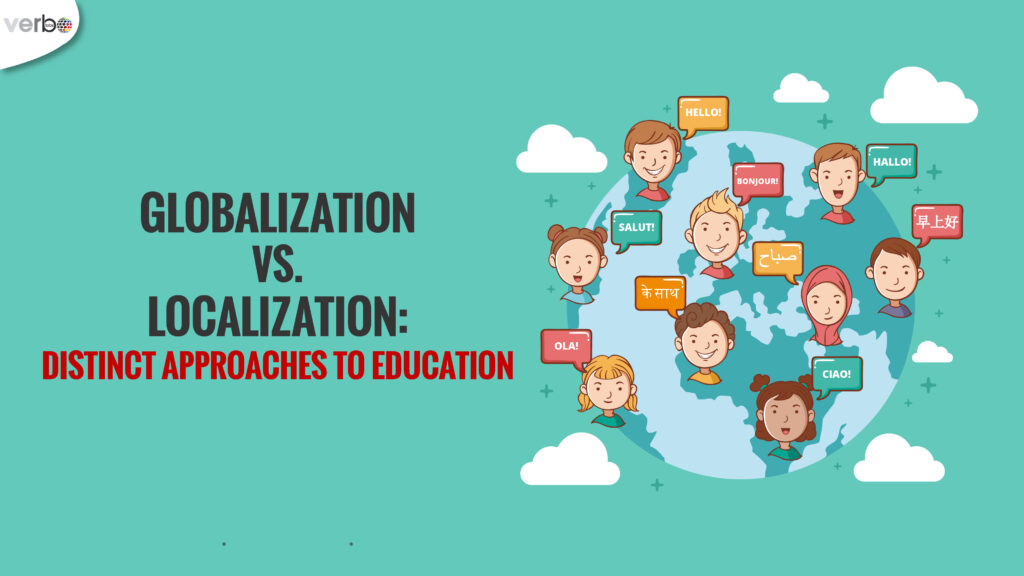Education is a fundamental aspect of human life, and it has undergone significant changes over the years. One of the most significant changes is the shift from a localized approach to a globalized approach.
Education is a dynamic field that constantly evolves to meet the changing needs of society. In recent decades, two contrasting approaches have emerged, each carrying its unique set of advantages and challenges—globalization and localization. These approaches reflect how education systems grapple with the tension between embracing a globalized world and preserving local identity. In this blog, we will explore the differences between globalization and localization in education and how they impact the learning process.
What is Globalization?
Globalization is the process of integrating economies, societies, and cultures through the exchange of goods, services, and ideas. In the context of education, globalization refers to the standardization of educational practices, policies, and curricula across different countries. The goal of globalization is to create a common educational framework that can be applied globally.
What is Localization?
Localization, on the other hand, is the process of adapting educational practices, policies, and curricula to meet the needs of a specific region or community. The goal of localization services is to create an educational framework that is tailored to the unique needs of a particular region or community.
Differences between Globalization and Localization
The primary difference between globalization and localization is the scope of their application. Globalization aims to create a common educational framework that can be applied globally, while localization aims to create an educational framework that is tailored to the unique needs of a particular region or community.
Another significant difference is the level of standardization. Globalization emphasizes uniformity and standardization to some extent, in order to facilitate global interactions and communications. Localization emphasizes customization and adaptation to the local context, accommodating unique linguistic and cultural characteristics.
Examples of Globalization and Localization in Education
Globalization
One example of globalization in education is the International Baccalaureate (IB) program. The IB program is a standardized educational framework that is recognized globally. It aims to provide students with a well-rounded education that prepares them for success in a globalized world.
Localization
An example of localization in education is the incorporation of local languages and cultures into the curriculum. In India, for instance, the government has introduced the Mother Tongue-Based Multilingual Education (MTB-MLE) program, which aims to promote the use of local languages in education. The program recognizes that students learn better when they are taught in their mother tongue.
Globalization in Education
Globalization in education is characterized by the integration of international perspectives, curricula, and standards. This approach aims to prepare students for a rapidly changing global economy, fostering a sense of interconnectedness and cultural awareness. Key features of a globalized education system include:
- International Curricula: Globalized education often adopts curricula that draw from international standards, such as the International Baccalaureate (IB) or Cambridge Assessment International Education. This allows students to access a standardized education recognized worldwide.
- Cross-Cultural Experiences: Globalization encourages cross-cultural experiences, such as exchange programs, multicultural events, and collaborative projects with students from different parts of the world. This exposure helps students develop a global perspective and cultural competence.
- Language Diversity: Globalized education often emphasizes the importance of learning multiple languages to facilitate effective communication in an interconnected world. This promotes linguistic diversity and opens up opportunities for students to engage with different cultures.
- Technology Integration: The use of technology is a hallmark of a globalized education system. Virtual classrooms, online resources, and collaborative platforms enable students to connect and learn beyond geographical boundaries.
Localization in Education
Localization services in education emphasizes the importance of preserving local cultures, languages, and values within the educational system. This approach seeks to maintain a connection between education and the unique identity of a community or region. Key features of a localized education system include:
- Cultural Relevance: Localized education places a strong emphasis on integrating culturally relevant content into the curriculum. This includes local history, traditions, and values that are important to the community.
- Language Preservation: In a localized education system, there is a focus on preserving and promoting the use of local languages. This helps maintain linguistic diversity and ensures that students are grounded in their cultural roots.
- Community Engagement: Localized education often involves close collaboration with the community. This includes input from local leaders, parents, and cultural experts to tailor the educational experience to the needs and values of the community.
- Customized Curriculum: Unlike standardized global curricula, localized education systems allow for more flexibility in curriculum design. This flexibility enables educators to adapt teaching materials to better suit the unique context of the local community.
More points to consider regarding Globalization and Localization
- Globalization has led to the standardization of education, which can be beneficial in some cases. For example, it can help students who move frequently between countries to have a consistent educational experience. However, it can also lead to a loss of cultural identity and diversity.
- Localization can help preserve cultural identity and diversity, but it can also lead to a lack of standardization and quality control. For example, if each region has its own educational framework, it can be difficult to compare the quality of education across regions.
- Another example of globalization in education is the rise of Massive Open Online Courses (MOOCs). MOOCs are online courses that are available to anyone, anywhere in the world. They provide a standardized educational experience that can be accessed globally.
- An example of localization in education is the use of local examples and case studies in the curriculum. This can help students relate to the material and understand how it applies to their own lives.
- It’s important to note that globalization and localization are not mutually exclusive. In fact, many educational frameworks incorporate elements of both approaches. For example, the International Baccalaureate (IB) program is a standardized educational framework that is recognized globally, but it also allows for local variations in the curriculum.
Conclusion
Globalization and localization are two distinct approaches to education, each with its own advantages and disadvantages. While globalization aims to create a common educational framework that can be applied globally, localization aims to create an educational framework that is tailored to the unique needs of a particular region or community. Both approaches have their place in education, and it is up to educators to determine which approach is best suited for their students.



